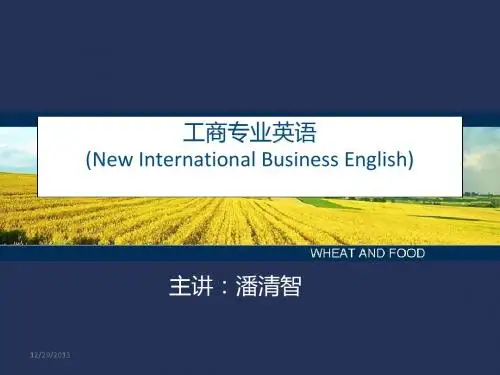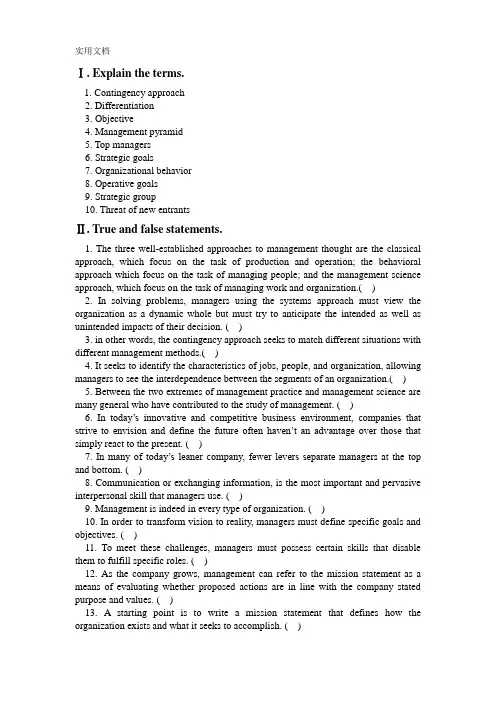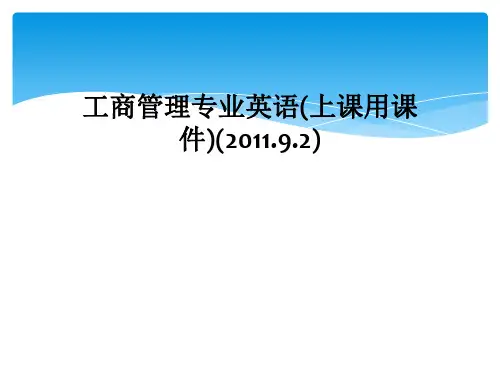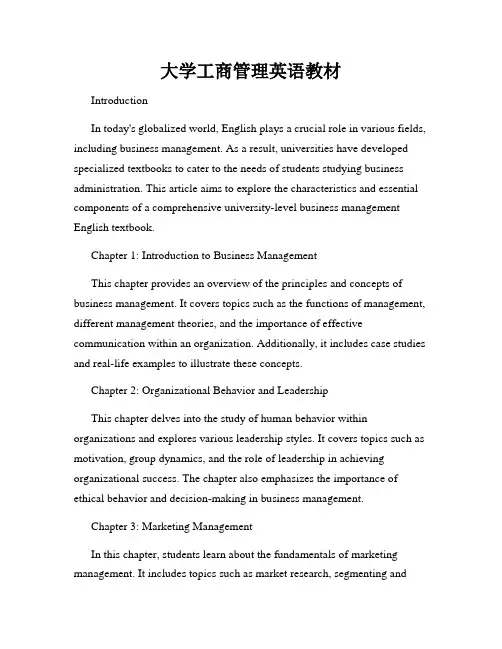工商管理专业英语1-Introduction课件
- 格式:ppt
- 大小:3.41 MB
- 文档页数:16





Ⅰ. Explain the terms.1. Contingency approach2. Differentiation3. Objective4. Management pyramid5. Top managers6. Strategic goals7. Organizational behavior8. Operative goals9. Strategic group10. Threat of new entrantsⅡ. True and false statements.1. The three well-established approaches to management thought are the classical approach, which focus on the task of production and operation; the behavioral approach which focus on the task of managing people; and the management science approach, which focus on the task of managing work and organization.( )2. In solving problems, managers using the systems approach must view the organization as a dynamic whole but must try to anticipate the intended as well as unintended impacts of their decision. ( )3. in other words, the contingency approach seeks to match different situations with different management methods.( )4. It seeks to identify the characteristics of jobs, people, and organization, allowing managers to see the interdependence between the segments of an organization.( )5. Between the two extremes of management practice and management science are many general who have contributed to the study of management. ( )6. In today’s innovative and competitive business environment, companies that strive to envision and define the future often haven’t an advantage over those that simply react to the present. ( )7. In many of today’s leaner company, fewer levers separate manag ers at the top and bottom. ( )8. Communication or exchanging information, is the most important and pervasive interpersonal skill that managers use. ( )9. Management is indeed in every type of organization. ( )10. In order to transform vision to reality, managers must define specific goals and objectives. ( )11. To meet these challenges, managers must possess certain skills that disable them to fulfill specific roles. ( )12. As the company grows, management can refer to the mission statement as a means of evaluating whether proposed actions are in line with the company stated purpose and values. ( )13. A starting point is to write a mission statement that defines how the organization exists and what it seeks to accomplish. ( )14. Technical skills are more important at lower organization levels.( )15. There are organizations that exist with balance sheets, capital assets, financial plans, or formal marketing strategies, but without people.( )16. Organizations are not random collections of people. ( )17. Organizations have many goals and operative goal are general and abstract. ( )18. Sometimes the coordination in organizations is a matter of absolute necessity rather than efficiency. ( )19. Individuals have intellectual and physical limitation which can only be overcome by organized group effort. ( )20. One important, although often implicit, official goal of all organizations is development. ( )21. Members must occasionally engage in innovative activities that go beyond their usual assignments. ( )22. Clearly these (often implicit) people-related operative goals are separate and independent from official goals. ( )23. Organizations are designed to continue achieve their goals even if certain members aren’t replaced. ( )24. One important, although often implicit, official goal of virtually all organizations is survival. ( )25. When there is little product differentiation, competition between present competitors is greater. ( )26. When strong product differentiation exists, the entry is easier. ( )27. Suppliers are especially important when their product is large part of buyer’s value added. ( )28. If buyers earn low profits and product involved is important part of their cost, then the bargaining will be less aggressive. ( )29. Different market segments need different bundles and different product. ( )30. An unattractive industry couldn’t lead the firm into withdrawal strategies or an attempt to form an alliance with competitors. ( )31. There are five interactive competitive forces that collectively determine an industry’s long-term attractiveness: present competitors, potential competitors, the bargaining power of suppliers and buyers, and substitute product. ( )32. New competitors add capacity to the industry and bring with them the need to gain market share, thereby marketing competition more intense. ( )33. Its impact can be significant, particularly when a limited number of suppliers service a number of same industries. ( )34. All four competitive forces just discussed above are affected by the passage of time; therefore, their strength varies as the industry passes from its introductory stage to its growth stage and on to maturity, followed by decline. ( )35. During the maturity period, competition forces are at their strongest, and many competitors are forced to exit the industry. ( )36. Management entails planning, organizing, coordinating, leading, and controlling resource to efficiently reach these goals. ( )37. In addition to setting goals and assuming various roles, managers also employskills that fall into three basic categories: information, technical and conceptual skills. ( )38. Managers around the world use more of a contingency to survive. ( )39. First-line managers set operational objectives, which define the results necessary to achieve both the tactic objectives and the strategic goals. ( )40. The field of organizational behavior is concerned with the influence that only formal grouping has on the individuals. ( )Ⅲ.Translate the following into Chinese.1. Learning about management is important for two reasons. First, our society depends on specialized institutions and organizations to provide the goods and services we desire. These organizations are guided and directed by the decisions of one or more individuals designated as “managers”. Second, individuals not trained as managers often find themselves in managerial positions. Many individuals presently being trained to be teachers, accountants, musicians, salespersons, artists, physicians, or lawyers will one day earn their livings as managers.2. All five competitive forces just discussed above are affected by the passage of time; therefore, their strength varies as the industry passes from its introductory stage to its growth stage and on to maturity, followed by decline. Competitive forces are apt to be weakest during the fast-growth period, thus, there are substantial opportunities for gaining market share. During the shakeout period, competition forces are at their strongest, and many competitors are forced to exit the industry. During the industry maturity, competitions typically slackens, but only if the industry leader holds a strong relative position.3.The grouping that characterizes organizations is of interest to the field of organizational behavior for several reasons. First, much of the work ( both intellectual and physical ) done in organizations is quite literally performed by groups, whether they are short-term task forces or formal work groups shown on an organizational chart. We are therefore interested in predicting and explaining the functioning of these groups and controlling them so that they function effectively. You will recall that the two-person news writing/news reading team was severely disrupted by Russ’s resignation. Secondly, everyone is aware that informal grouping occurs in all organizations. That is, friendships develop and informal alliances are formed to accomplish required work: Such grouping is not prescribed by the organization and not shown on the chart, but it can have an important impact upon goal achievement. Consequently, we are interested in how such groups’ form and what their exact impact is. Finally, the field of organizational behavior is concerned with the influence that both formal and informal grouping has on the individuals who enter organizations with their own particular needs and values.4. In addition to setting goals and assuming various roles, managers also employ skills that fall into three basic categories: interpersonal, technical, and conceptual skills. As managers rise through the hierarchy, they may need to strengthen their abilities in one or more of these skills; fortunately, managerial skills can usually be learned.Ⅳ.Translate the following into English.1.在这种情况下,为了使整个体系达到其目的,折中的做法是必要的。






大学工商管理英语教材IntroductionIn today's globalized world, English plays a crucial role in various fields, including business management. As a result, universities have developed specialized textbooks to cater to the needs of students studying business administration. This article aims to explore the characteristics and essential components of a comprehensive university-level business management English textbook.Chapter 1: Introduction to Business ManagementThis chapter provides an overview of the principles and concepts of business management. It covers topics such as the functions of management, different management theories, and the importance of effective communication within an organization. Additionally, it includes case studies and real-life examples to illustrate these concepts.Chapter 2: Organizational Behavior and LeadershipThis chapter delves into the study of human behavior within organizations and explores various leadership styles. It covers topics such as motivation, group dynamics, and the role of leadership in achieving organizational success. The chapter also emphasizes the importance of ethical behavior and decision-making in business management.Chapter 3: Marketing ManagementIn this chapter, students learn about the fundamentals of marketing management. It includes topics such as market research, segmenting andtargeting the market, developing marketing strategies, and analyzing consumer behavior. Practical exercises and case studies are provided to enhance students' understanding and application of marketing concepts.Chapter 4: Financial ManagementFinancial management is a crucial aspect of business administration. This chapter introduces students to the basics of financial management, including financial statement analysis, budgeting, and capital investment decisions. It also addresses the importance of financial planning and forecasting for sustainable business growth.Chapter 5: Human Resource ManagementThis chapter focuses on the management of human resources within organizations. It covers topics such as recruitment and selection, training and development, performance appraisal, and employee relations. The chapter also highlights the significance of effective human resource management in building a motivated and productive workforce.Chapter 6: Operations ManagementOperations management is essential for efficient production and service delivery. This chapter explores concepts such as production planning, supply chain management, quality control, and process improvement. Students are encouraged to think critically and apply these concepts to real-world business scenarios.Chapter 7: International BusinessIn today's interconnected world, international business plays a crucial role in the global economy. This chapter provides an overview of international trade, global market entry strategies, cultural considerations, and the challenges of managing multinational corporations. It also discusses the importance of cross-cultural communication and understanding in international business scenarios.Chapter 8: Entrepreneurship and Small Business ManagementEntrepreneurship is the driving force behind innovation and economic development. This chapter introduces students to the fundamentals of entrepreneurship, including opportunity identification, business planning, and risk management. It also emphasizes the unique challenges and opportunities associated with managing small businesses.ConclusionA comprehensive university-level business management English textbook should cover various aspects of business administration, including principles of management, marketing, finance, human resources, operations, international business, and entrepreneurship. By incorporating case studies, real-life examples, and practical exercises, such a textbook can provide students with the necessary knowledge and skills to excel in the field of business management.。